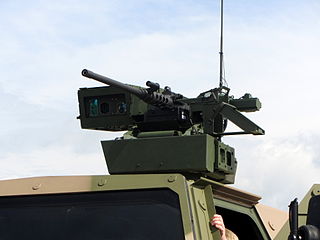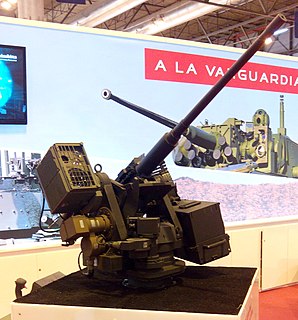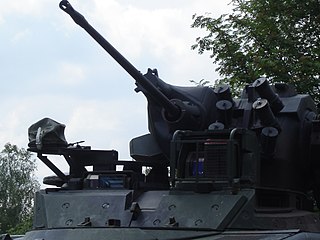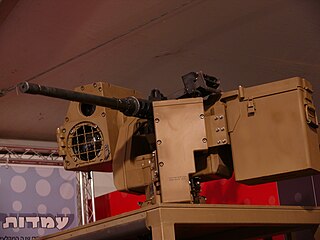 W
WA remote controlled weapon station (RCWS), or remote weapon station (RWS), also known as a remote weapon system, (RWS) is a remotely operated weaponized system often equipped with fire-control system for light and medium-caliber weapons which can be installed on ground combat vehicle or sea- and air-based combat platforms. Such equipment is used on modern military vehicles, as it allows a gunner to remain in the relative protection of the vehicle. It may also be retrofitted onto existing vehicles, for example, the CROWS system is being fitted to American Humvees and the Thales SWARM for Bushmaster IMVs of the Royal Netherlands Army.
 W
WThe 2A28 Grom is the main armament of the BMP-1 and BMD-1 infantry fighting vehicles. It is a 73 mm low pressure smoothbore semi-automatic gun with a wedge breech block. Development of the 2A28 Grom was directly linked to that of the SPG-9 recoilless gun; both fired projectiles similar to rocket-propelled grenades.
 W
WThe Bofors 40 mm gun, often referred to simply as the Bofors gun, is an anti-aircraft autocannon designed in the 1930s by the Swedish arms manufacturer AB Bofors. It was one of the most popular medium-weight anti-aircraft systems during World War II, used by most of the western Allies as well as some captured systems being used by the Axis powers. A small number of these weapons remain in service to this day, and saw action as late as the Persian Gulf War.
 W
WThe Brandt 60 mm Long Range gun-mortar is a breech loading mortar capable of firing on a flat trajectory. It was developed from the Brandt Mle CM60A1 and resembles a long-barrelled, long-ranged variant of that weapon.
 W
WThe Brandt Mle CM60A1, also known as the Brandt HB 60LP, MCB-60 HB, or simply as the Brandt 60mm LP Gun-Mortar, is a 60mm gun-mortar. Unlike conventional infantry mortars, it was not designed to be mounted on a bipod and a baseplate, but rather in the turrets of armoured fighting vehicles. The CM60A1 could be fired at a very low angle of elevation, giving it the dual purpose of direct fire artillery. Its hydraulic recoil mechanism reduces peak loads, allowing it to be mounted in very light armoured cars, such as the Panhard AML-60, or wheeled armoured personnel carriers, like the Panhard M3.
 W
WThe Bushmaster III is a 35 mm automatic/semi-automatic cannon designed and built by Alliant Techsystems, based on the 25 mm M242 Bushmaster. The weapon has been selected as primary armament for the export versions of the CV90 infantry fighting vehicles (IFV) currently in service with the Danish, Dutch and Estonian armies.
 W
WFLW stands for "remotely operated, light weapon station" developed by the German defence company Krauss-Maffei Wegmann brands its family of remote weapon stations.
 W
WThe Hitrole is a remote weapons station manufactured by Italian arms company Oto Melara . The "role" portion of the name is short for "Remotely Operated, Light Electrical".
 W
WThe M242 Bushmaster chain gun is a 25 mm (25×137mm) single-barrel chain-driven autocannon. It is used extensively by the U.S. military, such as in the Bradley fighting vehicle, as well as by other NATO members and some other nations in ground combat vehicles and various watercraft. It was designed and manufactured originally by Hughes Helicopters in Culver City, California. The company was acquired by McDonnell Douglas Helicopters in 1985, which merged into Boeing Corporation in 1997. In 2002, it was sold again to Alliant Techsystems, which merged with Orbital Sciences Corporation in 2015 to form Orbital Science ATK and was, in turn, bought out by Northrop Grumman in 2018. As of 2019, it is produced by Northrop Grumman Innovation Systems.
 W
WThe Mk44 Bushmaster II is a 30 mm chain gun manufactured by Northrop Grumman. It is a derivative of the 25 mm M242 Bushmaster, and uses 70% of the same parts as the M242 while increasing the firepower by as much as 50% with the 20% increase in caliber size. The barrel is chromium-plated for extended life. The gun uses standard GAU-8 Avenger ammunition that is available in API, HEI and APFSDS-T variants. The gun can be converted to a caliber of 40x180 mm, which involves changing the barrel and a few key parts, to use the SuperShot 40 cartridge. It can also be converted to use the 30x170 mm RARDEN cartridge.
 W
WThe Protector Remote Weapon Station is a remotely controlled weapons station (RWS) that can be mounted to vehicles and stationary platforms. It has been in full scale production since December 2001. It is manufactured by Kongsberg Defence Systems of Norway and Thales Group of France.
 W
WThe Rafael Overhead Weapon Station is a remote weapon station developed by Rafael Advanced Defense Systems in cooperation with the Israel Defense Forces. It has been superseded by the Rafael Samson Remote Controlled Weapon Station (RCWS). However, the larger Rafael OWS-25 and OWS-25R models are still in production.
 W
WThe L21A1 RARDEN is a British 30mm autocannon used as a combat vehicle weapon. The Royal Armament Research and Development Establishment (RARDE) and the Royal Small Arms Factory (RSAF), Enfield, at the time, were both part of the Ministry of Defence.
 W
WThe Reutech Rogue remote weapon system is a remotely controlled turret system for weapons ranging from 7.62 mm general purpose machine guns up to 20 mm cannons or a 40mm automatic grenade launcher. A version for anti-tank guided missiles has also been developed. There are versions for land and maritime use manufactured in South Africa by Reutech Solutions.
 W
WThe Rheinmetall Mk 20 RH-202 is a 20 mm caliber autocannon designed and produced by Rheinmetall. It fires the 20×139mm ammunition originally developed for the Hispano-Suiza HS.820.
 W
WThe Samson Remote Controlled Weapon Station (RCWS), also known as Katlanit is a Remote Weapon System that enables a variety of devices to be operated automatically or by remote control, including 5.56 mm, 7.62 mm, and 12.7 mm .50 BMG machine guns, 40 mm automatic grenade launchers, anti-tank missiles and observation pods. There are a total of three variants of the Samson family:Samson Jr. ROWS - for 5.56 mm and 7.62 mm machine guns, weighing 60–75 kg (132–165 lb). Mini Samson ROWS - for 12.7 mm and 14.5 mm machine guns, as well as 40 mm grenade launcher, weighing 140–160 kg (310–350 lb), similar to that of Mini Typhoon naval ROWS and OWS. Standard Samson - for guns with calibre ranging from 20–40 mm (0.79–1.57 in), weighing 1.5 tonnes, similar to that of standard Typhoon naval ROWS and OWS.
 W
WThe Sharpshooter Turret was developed by BAE Systems in 1980. In 1995–1997 it was updated for production by BAE Systems and FNSS Defence Systems. The turret is a one-man stabilized turret and can be equipped with one of three configurations: dual weapon system incorporating a rapid firing M242 Bushmaster 25 mm cannon, or 40 mm grenade launcher, or 12.7 mm machine gun, along with a coaxially mounted 7.62 mm machine gun. These weapons are mechanically linked to a gunner’s day/night sighting system incorporating a Thermal Imager and Laser Rangefinder.
 W
WThe Shipunov 2A42 is a Soviet/Russian 30 mm autocannon. It is built by the Tulamashzavod Joint Stock Company.
 W
WThe SWARM Remote Weapon System is a fully armored remote weapon system designed and built by the Thales Group in Glasgow, Scotland. The SWARM system consists of two main assemblies: the Gun Processing and Interface Unit (GPIU), which is operated inside the vehicle, and the external Weapon and Sensor Platform (WASP). It can fire a variety of weapons, and utilize multiple sensors. On the US Marine Corps' Gladiator Tactical Unmanned Ground Vehicle (TUGV), it is equipped with a 7.62 mm M240 and day/night sensors.
 W
WSwingfire was a British wire-guided anti-tank missile developed in the 1960s and produced from 1966 until 1993. The name refers to its ability to make a rapid turn of up to ninety degrees after firing to bring it onto the line of the sighting mechanism. This means that the launcher vehicle could be concealed and the operator, using a portable sight, placed at a distance in a more advantageous firing position.
 W
WThe Tucker gun turret was a fast-traversing electrically powered gun turret widely described as having been mounted on World War II bombers and on some ground vehicles and small naval vessels like US Navy PT boats. American industrialist Preston Tucker first developed the turret for the experimental Tucker armored car in 1938.
 W
WThe XM913 is an experimental American chain gun produced at Picatinny Arsenal. The cannon is a larger and more modern version of the 25 mm Bushmaster cannon. Although its shells, 50 x 228 mm, are twice the diameter of the 25mm M242 Bushmaster, the 50mm cannons is not much longer than the smaller weapon. The overall lengths of the 25mm cannon and 50mm cannon are 105.2 centimetres (41.4 in) and 157.7 centimetres (62.1 in), respectively; while the portion of the gun that intrudes into the turret are 30.0 centimetres (11.8 in) and 40.1 centimetres (15.8 in), respectively.